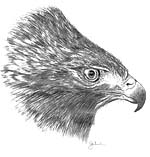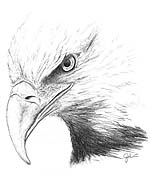 Accipiters, Eagles,
Falcons, Hawks & Vultures
Accipiters, Eagles,
Falcons, Hawks & Vultures 
Accipter, Aquila, Buteo,Cathartes & Falco
These orders contains some of the most majestic fliers and soaring birds in the bird kingdom. Also known as raptors, huting birds or birds of prey, they are diurnal flesh eaters. Some species take their prey live while some are scavengers. They all have the same physical characteristics: a heavy hooked beak and toes with strong curved talons. Males and females have the same general plumage, though females tend to be larger than males. This is known as sexual dimorphism.
They are found throughout the world except in Antarctica. Though the terms "hawk" and "falcon" are used by people to mean a bird of prey, hawks and falcons are quite different from each other, as are accipiters, or bird hunting raptors. Eagles also comprise a different group within the term raptor. Owls are also raptors but in a different order.Vultures are included in the group since they also feed on meat, but as scavengers. The role vultures play in maintaining a healthy environment is crucial.
The illustrations and photos on these pages are from my many years of being out in the field, rescuing injured wildlife, volunteering as an animal care aide at the Santa Barbara Zoo and traveling abroad.
Accipters are very agile small to medium-sized birds of prey
that use soaring, sprinting, and
slow flight to catch their prey. Think of them as fighter or pursuit planes.
While they tend to take other birds as prey, they are know to feed on whatever is available too.
Hawks are one of the largest subfamilies of Accipitidae These tend to be large soaring birds that fly or thermal and then dive or stoop on their prey. They usually have broad wings, a large body and a broad tail. Most North American hawks do not migrate butSwainson's Hawk does fly from North America to Argentina in its migration cycle. Owls have fasinated man for centuries. Maligned over time by different cultures and societies and revered by others, there is little doubt this night-flying silent hunter is quite adapted in it role as a predator and hunter. Owls come in many sizes, from giant Eagle Owls to the small Pygmy Owls that can fit in the palm of your hand. Here are just a few of the many I've had the pleasure to see and handled.
Birds of prey have very keen eyesight as well as the ability to dive or stoop at great speeds to capture their prey. The Peregrine Falcon, Falco peregrinus, can attain a speed of over 200 mph in a stoop while a White-tail Kite, Elanus leucurus, hovers or kites over it's prey and then drops down feet first to capture its prey, hence the name "kite."
In order to fly, birds have evolved over time with some unusual body systems which are not the same as those of mammals or fish. Their bones are less dense than those of mammals or fish, they have no teeth (teeth add weight) and their digestive system has evolved to one that also helps keep their body weight down. A lower body weight makes it easier to take off and fly. The need to keep weight as low as possible also means they can only store a certain amount of fat, even when they are migrating. An efficient digestive systems means birds eat and digest food as quickly and efficiently as possible. Birds do not create bulky feces like mammals, but rather liquid like droppings. Again, this is the result of a digestive system which has evolved to keep body weight down and yet allow sufficient digestion of ingested food.
Because birds of prey consume flesh, fur and bones, they include more more step in the digestion of food. After all the items have been broken down and absorbed by their system the remaining parts, such as fur and bone are compacted and regurgitated by the bird. These are known as pellets.
Take a pellet apart and you will see what that bird of prey has been eating.